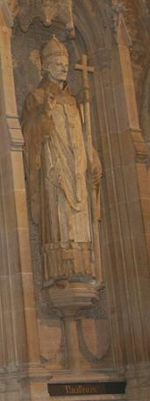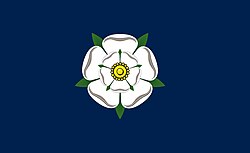Portal:Yorkshire
The Yorkshire Portal
Yorkshire (/ˈjɔːrkʃər, -ʃɪər/ YORK-shər, -sheer) is an area of Northern England which was historically a county. Despite no longer being used for administration, Yorkshire retains a strong regional identity. The county was named after its original county town, the city of York.
The south-west of Yorkshire is densely populated, and includes the cities of Leeds, Sheffield, Bradford, and Wakefield. The north and east of the county are more sparsely populated, however the north east includes the southern part of the Teesside conurbation, and the port city of Kingston upon Hull is located in the south-east. York is located near the centre of the county. Yorkshire has a coastline to the North Sea to the east. The North York Moors occupy the north east of the county, and the centre contains the Vale of Mowbray in the north and the Vale of York in the south. The west contains part of the Pennines, which form the Yorkshire Dales in the north-west. (Full article...)
Selected article

The history of Sheffield, a city in South Yorkshire, England, can be traced back to the founding of a settlement in a clearing beside the River Sheaf in the second half of the 1st millennium AD. The area now known as Sheffield had seen human occupation since at least the last ice age, but significant growth in the settlements that are now incorporated into the city did not occur until the Industrial Revolution.
Following the Norman conquest of England, Sheffield Castle was built to control the Saxon settlements and Sheffield developed into a small town, no larger than Sheffield City Centre. By the 14th century Sheffield was noted for the production of knives, and by 1600 it had become the main centre of cutlery production in England, overseen by the Company of Cutlers in Hallamshire. In the 1740s the crucible steel process was improved by Sheffield resident Benjamin Huntsman, allowing a much better production quality. At about the same time, the silver plating process which produced Sheffield Plate was discovered. The associated industries led to the rapid growth of Sheffield; the town was incorporated as a borough in 1843 and granted a city charter in 1893.
Sheffield remained a major industrial city throughout the first half of the 20th century, but the downturn in world trade following the 1973 oil crisis, technological improvements and economies of scale, and a wide-reaching rationalisation in steel production throughout the European Economic Community led to the closure of many of the steelworks from the early 1970s onward. Urban and economic regeneration schemes, initiated in the late 1980s, have since transformed the city. (read more . . . )
Selected image

Credit: Kyle McInnes
Skidby Windmill is a Grade II listed working windmill at Skidby near Beverley, in the East Riding of Yorkshire. Originally built in 1821, the mill was further extended to its current 5 stories in 1870. (read more . . . )
Selected biography

Paulinus (died 10 October 644) was a Roman missionary and the first Bishop of York. A member of the Gregorian mission sent in 601 by Pope Gregory I to Christianize the Anglo-Saxons from their native Anglo-Saxon paganism, Paulinus arrived in England by 604 with the second missionary group. Little is known of Paulinus' activities in the following two decades.
After some years spent in Kent, perhaps in 625, Paulinus was consecrated a bishop. He accompanied Æthelburg of Kent, sister of King Eadbald of Kent, on her journey to Northumbria to marry King Edwin of Northumbria, and eventually succeeded in converting Edwin to Christianity. Paulinus also converted many of Edwin's subjects and built some churches. One of the women Paulinus baptised was a future saint, Hilda of Whitby. Following Edwin's death in 633, Paulinus and Æthelburg fled Northumbria, leaving behind a member of Paulinus' clergy, James the Deacon. Paulinus returned to Kent, where he became Bishop of Rochester. After his death in 644, Paulinus was venerated as a saint. (read more . . . )
Selected list -

The Churches Conservation Trust, which was initially known as the Redundant Churches Fund, is a charity whose purpose is to protect historic churches at risk, those that have been made redundant by the Church of England. The Trust was established by the Pastoral Measure of 1968. The legally defined object of the Trust is "the preservation, in the interests of the nation and the Church of England, of churches and parts of churches of historic and archaeological interest or architectural quality vested in the Fund ... together with their contents so vested".
The Trust cares for over 350 churches. The charity is financed partly by the Department for Culture, Media and Sport and the Church Commissioners, but grants from those bodies were frozen in 2001, since when additional funding has come from other sources, including the general public. During the 2016-2017 period, the Trust's income was £9,184,283 and expenditures totaled £9,189,061; 92% of the latter was spent on front line projects. During that year it had 64 employees, and received the support of up to 2,000 volunteers. The charity is run by a board of trustees, who delegate the day-to-day management to a chief executive and his senior management team. (Full article...)List of selected lists
|
|---|
Selected Did You Know . . .

- ... that St Mary's Church, Whitby (pictured), was the setting for a scene from Bram Stoker's Dracula?
- ... that Butchers Wheel, a cutlery and tool factory in Sheffield, could only be accessed through a single, guarded door?
- ... that disputes between rival railway companies during the building of the Cleveland Railway became so intense that they led to a "battle" on the River Tees?
- ... that a large fragment of the Northumbrian Easby Cross was over 1,000 years old when it was found built into a wall in a field?
General images -
Subcategories
Selected panorama

Topics
Related portals
WikiProjects
Things you can do
Associated Wikimedia
The following Wikimedia Foundation sister projects provide more on this subject:
-
Commons
Free media repository -
Wikibooks
Free textbooks and manuals -
Wikidata
Free knowledge base -
Wikinews
Free-content news -
Wikiquote
Collection of quotations -
Wikisource
Free-content library -
Wikiversity
Free learning tools -
Wikivoyage
Free travel guide -
Wiktionary
Dictionary and thesaurus



















































